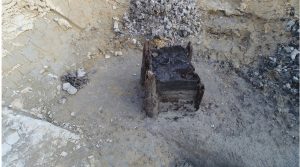Water management
Water management
in a history of Bohemia, Moravia and Silesia
Today, in a time of a distinct climate change, we witness an endangerment of humankind by a water deficiency caused by incoming aridity on the one hand and local floods caused by heavy rains on the other hand. These events are clear proof that we are not ready for a climate change and that current water management provisions are insufficient. Nevertheless, the appropriate water management belongs to the key strategies for the humankind survival and therefore we should be aware of it. Let´s pose a question, if there are any measures against uncontrolled loss of water known from the past (from prehistory to the Middle Ages). The answer is positive: e.g. a range of wells and cisterns, channels, aqueducts, sophisticated field systems around the Medieval villages, manners of tillage, embankments, ponds, dams, water reservoirs, irrigation systems, water mills etc. This project thus tries to evaluate manners and attitudes to the water management in the past as a source of knowledge and perhaps also presents a manual for the present and mainly for the future. It is possible to apply prepared models of a crisis solution elaborated at the example of one region (e. g. Czech Republic) in the other countries worldwide. Subject of the first phase of this far-reaching project dealing with the water management in prehistory and protohistory will be the simples and also the oldest features – wells ad cisterns, which are richly evidenced at numerous archaeological sites and therefore, there is a range of disponible (often even still unpublished) data concerning this topic.
Wells and cisterns belong to one of the forms of the local water preservation, utilization and supplying, constructed by past social communities. Surprisingly variable dating results of several water management facilities unearthed during recent excavations (e.g. Velim, Uničov, Pravčice and the most recent findings from the D35 highway rescue excavation dated back from the Neolithic up to the 8th century AD) have become an impulse for this project dealing with the water management in the area of the current Czech Republic in the prehistory, protohistory and in the Middle Ages. Next to the already mentioned sites, also other similar features from the studied area with various typological and chronological composition will be analysed. Among many research questions we can mention for example the issues of a presence or absence of wells (cisterns) in settlement areas (villages, hillforts, castles etc.), manners of a water distribution, allocation of the sites and the water sources (slope, distance from the closest stream, ground water level), employed technologies, typology, terminology, dating, use wear analyses (techno-morphology) or the environment reconstruction based on the analysis of the infills of the wells. Choice of the employed scientific analyses depends on the character of the infills of the wells and cisterns (sample floatation for macro-remains, palynological analysis etc.). Other aims of the project will be absolute dating (dendrochronology, radiocarbon dating), analyses of the finding contexts, hydrological conditions and modelling, environmental and palaeoecological reconstruction of the landscape, climate conditions and climate changes, problem of so called “water domestication”, water supplying (statistic and mathematic models), allocations of the settlements related to the wells (Ostrov, Kobylnice, Prašovice), non-destructive geophysical site prospections with a potential of finding of new wells and cisterns (Mohelnice, Velim, Brno – Starý Lískovec etc.) or 3-D reconstruction of the features. All data and results will be incorporated in the complex database of these water management features, which will enable a comparison with the results of research from other countries. Other water management features and other forms of water retention systems (channels, dams, aqueducts, ponds, pools, fens etc.) will be researched in a frame of a consequential project.

Neolithic well dated back to the Linear Pottery Culture was excavated at the Ostrov site in eastern Bohemia.

Detail of the wooden well construction from the Ostrov site after preparation.





